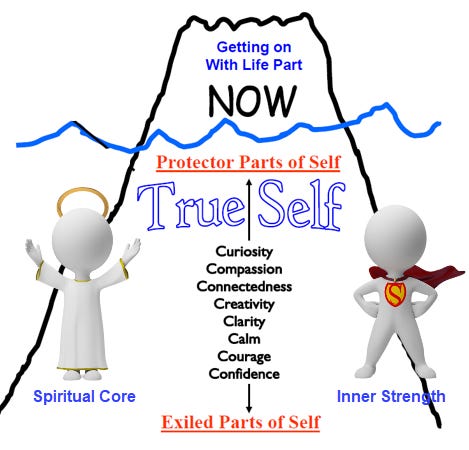🧩 Understanding Your Inner Family Roles: Managers, Firefighters, and Exiles
Integrating IFS, The Iceberg, and the Life Scripts & Parts Matrix Models
Before we go deeper into trauma recovery, it helps to map your “inner family.” In Internal Family Systems (IFS), we usually meet four key players:
Managers – planners, perfectionists, controllers. They try to prevent pain before it starts by keeping life tightly managed (perform, please, prove, perfect).
Firefighters – crisis responders. When pain breaks through, they rush in to put out the fire with numbing, distraction, anger, shutdown, over-eating, over-working, etc.
Exiles – young parts carrying the raw burdens of fear, shame, sadness, and aloneness. Managers and Firefighters try to keep Exiles out of awareness so we can function.
True-Self – your compassionate, calm, curious core. Self isn’t a “part”; it’s the leader who can help all parts feel safe, seen, and integrated.
Why this map matters
It explains why smart people get stuck in loops: protectors (Managers/Firefighters) work against short-term pain even if it costs long-term growth.
It helps you honor the intent (“you kept me safe”) while updating the strategy (“we can do this differently now”).
How to spot each role (you’ll recognize these)
Managers say things like:
“We need to get it exactly right.”
“Don’t risk it—stay invisible.”
“Keep everyone happy.”
They feel like: pressure in the chest, clenched jaw, mental to-do lists, scanning for flaws.
Firefighters say or do things like:
“Scroll, snack, sleep, do anything but feel.”
“Blow up! That’ll shut it down.”
“Numb out now; deal later.”
They feel like: urgency, heat, impulsivity… or fuzzy-slow numbness.
Exiles carry burdens like:
“I’m not good enough.” “No one could love me as I am.” “My needs don’t matter.” These are imprints from experience that later become core beliefs and fast automatic thoughts.
True-Self feels like:
Calm, Curiosity, Compassion, Clarity, Confidence, Courage, Creativity, and Connectedness (the “8 Cs”).
Body cues: breath drops into the belly, shoulders soften, vision widens, inner roominess.
Mini-practice: 7 minutes to shift from parts to Self
Notice & Name (1 min).
“Ah, a perfectionist Manager is here,” or “An avoiding Firefighter is here.”Thank the intent (1 min).
“Thank you for trying to keep me safe.”Ask two gentle questions (2 min).
“What are you afraid would happen if you stepped back 10%?”
“What do you need from me right now to feel safer?”
Offer an update (2 min).
“We’ll still do quality work, but with two passes, not eight. If anxiety rises above 6/10, we pause and breathe.”Check for a yes/no (1 min).
Notice the felt sense. If it’s a “no,” reduce the step (from 30 minutes to 10 minutes; from 3 tasks to 1).
This is how you honor protectors while inviting Self-leadership.
Everyday examples (so it sticks)
Manager loop: You re-write an email 7 times.
Self update: “Two clear passes, send, then record one learning.”Firefighter loop: You binge-scroll after a tense conversation.
Self update: “3 minutes of box breathing, then one compassionate text to a safe person.”Exile ache: “I’m not good enough.”
Self response: Translate the negation into a need: “I need reassurance and a small win.” Then take one action (ask for criteria; complete a 10-minute task).
Why this fits our Series
In Post 3 we explored Rational-Lies (beliefs that look/sound/feel true but aren’t). In Post 4 we showed why the subconscious ignores “don’t,” and how to replace what you don’t want with the presence of what you do want.
Today, you’ve got the map. In the next post, we’ll apply it to trauma: what happens when you can’t fight or flee—and how parts become prisoners of old roles until Self leads them into freedom.
Reflection prompts
Which protector shows up first under stress—Manager or Firefighter?
What Exile story might they be trying to protect (e.g., “I’m not enough,” “I’ll be rejected”)?
What’s one Self-led update you can offer them today?
More tools: Program Your Subconscious Mind



